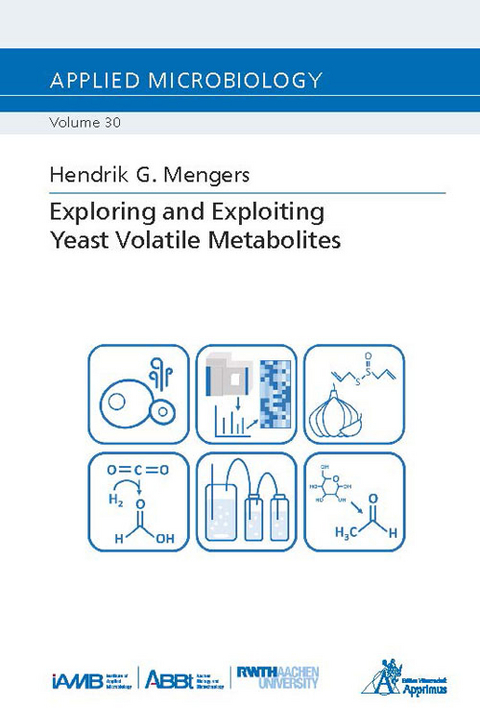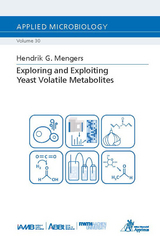Exploring and Exploiting Yeast Volatile Metabolites
Seiten
2023
Apprimus Verlag
978-3-98555-150-7 (ISBN)
Apprimus Verlag
978-3-98555-150-7 (ISBN)
While S. cerevisiae is one of the most used hosts in biotechnology, many aspects of its volatile metabolites are sparsely researched. This works aims to demonstrate different topics, for example how CO2 production can be avoided by combining bio- and chemocatalysis, how targeting the production of volatile compounds can lower downstream processing costs, and how SESI-Orbitrap MS opens new possibilities to measure the volatilome online in real-time.
The sensation of "smell", caused by volatile organic compounds, is native to all domains of life. The sum of all emitted molecules is called the volatilome but the exploration of microbial volatiles is a sparsely populated research field. Saccharomyces cerevisiae is a common host for modern biotechnology and has been used for the biotechnological production of ethanol for most of human civilisation, but still, the gas phase above fermentations is yet to be fully understood. This work aims to contribute to the knowledge of different aspects of the yeast volatilome: avoiding unwanted volatiles, overproducing valuable volatiles, and finding new methods to analyse volatiles.Carbon dioxide, even with the current fight against human-made climate change, is an often-neglected metabolite. Through complementing a bioethanol fermentation in an overpressure reactor with a Ru-catalyst in an organic phase and high H2 pressure, biogenic CO2 was converted to formic acid. Biotechnological production processes often suffer from high downstream purification costs, which could be minimised by overproducing volatile metabolites. One prime example is acetaldehyde, with a worldwide production of over 1 Mt/a, which is chiefly synthesised from petrochemical feedstocks. S. cerevisiae with completely deleted alcohol dehydrogenase activity was used to produce acetaldehyde from glucose. Because of the compound's low boiling point, it is inevitably stripped from the reactor and needs to be captured from the off-gas, for example through water traps.As a new method for volatilome analysis, SESI-Orbitrap MS was established on the example of the heat-labile allicin from garlic. This compound was measured from the gas phase over a solution of synthetic allicin, freshly crushed garlic, and from human breath after garlic consumption. Further, the differences between different Allium species were examined, showing the versatility of this measurement methodology.Lastly, the complete yeast volatilome was measured from fermentation off-gas online with a time resolution of 0.4 Hz. While the ethanol signal showed high agreement with standard measurement techniques, acetaldehyde as an example of low-abundance high-volatile compounds, was measured hours earlier. Two metabolic shifts were visible and in over 16,000 scans, over 200 compounds were identified by their molecular formula, each with their unique intensity profile.
The sensation of "smell", caused by volatile organic compounds, is native to all domains of life. The sum of all emitted molecules is called the volatilome but the exploration of microbial volatiles is a sparsely populated research field. Saccharomyces cerevisiae is a common host for modern biotechnology and has been used for the biotechnological production of ethanol for most of human civilisation, but still, the gas phase above fermentations is yet to be fully understood. This work aims to contribute to the knowledge of different aspects of the yeast volatilome: avoiding unwanted volatiles, overproducing valuable volatiles, and finding new methods to analyse volatiles.Carbon dioxide, even with the current fight against human-made climate change, is an often-neglected metabolite. Through complementing a bioethanol fermentation in an overpressure reactor with a Ru-catalyst in an organic phase and high H2 pressure, biogenic CO2 was converted to formic acid. Biotechnological production processes often suffer from high downstream purification costs, which could be minimised by overproducing volatile metabolites. One prime example is acetaldehyde, with a worldwide production of over 1 Mt/a, which is chiefly synthesised from petrochemical feedstocks. S. cerevisiae with completely deleted alcohol dehydrogenase activity was used to produce acetaldehyde from glucose. Because of the compound's low boiling point, it is inevitably stripped from the reactor and needs to be captured from the off-gas, for example through water traps.As a new method for volatilome analysis, SESI-Orbitrap MS was established on the example of the heat-labile allicin from garlic. This compound was measured from the gas phase over a solution of synthetic allicin, freshly crushed garlic, and from human breath after garlic consumption. Further, the differences between different Allium species were examined, showing the versatility of this measurement methodology.Lastly, the complete yeast volatilome was measured from fermentation off-gas online with a time resolution of 0.4 Hz. While the ethanol signal showed high agreement with standard measurement techniques, acetaldehyde as an example of low-abundance high-volatile compounds, was measured hours earlier. Two metabolic shifts were visible and in over 16,000 scans, over 200 compounds were identified by their molecular formula, each with their unique intensity profile.
| Erscheint lt. Verlag | 15.3.2023 |
|---|---|
| Reihe/Serie | Applied Microbiology ; 30 |
| Verlagsort | Aachen |
| Sprache | englisch |
| Maße | 148 x 210 mm |
| Gewicht | 285 g |
| Themenwelt | Naturwissenschaften ► Biologie ► Mikrobiologie / Immunologie |
| Schlagworte | Hefe • Massenspektometrie • Mikrobiologie • Naturwissenschaften • volatile Stoffe |
| ISBN-10 | 3-98555-150-2 / 3985551502 |
| ISBN-13 | 978-3-98555-150-7 / 9783985551507 |
| Zustand | Neuware |
| Haben Sie eine Frage zum Produkt? |
Mehr entdecken
aus dem Bereich
aus dem Bereich
Allgemeine Grundlagen und spezielle Anwendungen
Buch | Softcover (2021)
Springer Berlin (Verlag)
54,99 €




